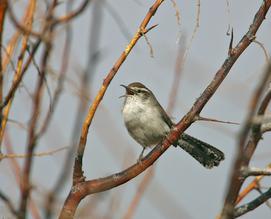BEWICK'S WREN CO-142
Climbing the Rockies: juniper habitat, Temple Canyon Park, Canyon City, Colorado
June 8, 6:03 a.m.
Sunrise at 5:37 a.m.
They're extinct east of the Mississippi River now, and we hear our first Bewick's wren in Missouri, where they sound much as they do in Colorado. We will next hear them in Oregon, west of the Cascades, where their songs are entirely different.
Given my long history with Bewick's wrens, how I cut my scientific teeth on these birds as a graduate student at Oregon State University from 1969 to 1972, I have an enormous fondness for their songs, and the complex songs of Colorado birds are especially fine.
I'm puzzled by what he's doing here, though. He sings five different songs in this twelve and a half minute selection, but it's the manner in which he does so that is unique. He begins with two examples of one song (2A), then goes to my favorite, a four-second masterpiece, singing it seven times (7B). The next song he sings 12 times (12C). That's the normal style of singing by a Bewick's Wren, singing one song several times before switching to another, with a Colorado male gradually working through a repertoire of ten or so songs in this way.
At 3:10, however, he reverts back to song B, singing it eight more times (8 B). Then he introduces another song (22D), singing it until about 7:20, but then reverts back again to B, alternating it with song D (B D 8B D B D B D). As if to say he's finished with all of this fussing, he introduces a new song and stays there for 16 songs (16E). Then, however, he returns to song D, singing it five more times before this selection ends (5D). That's not the way a Bewick's wren typically sings.
If I put the entire 87-song sequence together, here it is: 2A 7B 12C 8B 22D B D 8B D B D B D 16E 5D. What's in his head? Is he responding to something that the neighboring Bewick's wren is singing, and that keeps him from advancing cleanly through his song repertoire? I wonder. All those calls between songs beginning at 4:16 certainly shows he's excited about something, and that something is no doubt causing the unique song delivery here.
And, I couldn't resist, of course, measuring the wing beat rate for the broad-tailed hummingbird in the background at about 4:15. 10 beats in 0.231 seconds = 43 beats/second, the very same rate I've calculated before for this species.
Background
A distant Bewick's wren with which this bird is countersinging, heard first at 0:04 if you listen closely. Mourning dove, black-headed grosbeak, mountain chickadee, spotted towhee, broad-tailed hummingbird.

Photo by John Van de Graaff
